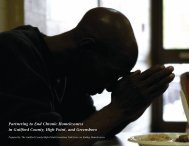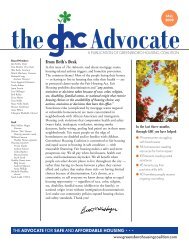data - Greensboro Housing Coalition
data - Greensboro Housing Coalition
data - Greensboro Housing Coalition
You also want an ePaper? Increase the reach of your titles
YUMPU automatically turns print PDFs into web optimized ePapers that Google loves.
transitional housing) or unsheltered (i.e., in a place not meant for human habitation)<br />
on that night.<br />
<br />
The HMIS <strong>data</strong> provide a more detailed demographic profile of sheltered homeless<br />
people and their use of the residential services system during a one-year period.<br />
The estimated totals for 2008 are that:<br />
<br />
<br />
About 664,000 people were homeless—sheltered and unsheltered—on a single night<br />
in January 2008.<br />
About 1.6 million people were homeless in emergency shelters or transitional housing<br />
at some point during the year between October 1, 2007 and September 30, 2008.<br />
Definitions of Key Terms<br />
1. Individuals: The HMIS-based estimates of sheltered homeless individuals include single<br />
adults, unaccompanied youth, persons in multi-adult households, and persons in multi-child<br />
households. A multi-adult household is a household composed of adults only—no children<br />
are present. A multi-child household is composed of children only (e.g., parenting youth)—<br />
no adults are present.<br />
2. One-Year Sheltered Counts: 12-month counts of homeless persons who use an<br />
emergency shelter or transitional housing program at any time from October though<br />
September of the following year. The one-year counts are derived from communities’<br />
administrative <strong>data</strong>bases, or Homeless Management Information Systems (HMIS).<br />
3. Persons in Families: The HMIS-based estimates of homeless persons in families include<br />
persons in households with at least one adult and one child.<br />
4. Point-in-Time (PIT) Counts: One-night counts of both sheltered and unsheltered<br />
homeless populations. The one-night counts are reported on CoC applications and reflect<br />
a single-night during the last week in January.<br />
5. Principal City: Following guidance from the U.S. Office of Management and Budget, the<br />
AHAR replaces the term “central city” with “principal city.” The largest city in each<br />
metropolitan or micropolitan statistical area is designated a principal city, and other<br />
cities may qualify if specified requirements (population size and employment) are met.<br />
6. Sheltered: A homeless person who is in an emergency shelter or transitional housing<br />
program for homeless persons.<br />
7. Unsheltered: A homeless person who is living in a place not meant for human habitation,<br />
such as the streets, abandoned buildings, vehicles, parks, and train stations.<br />
Introduction 3




